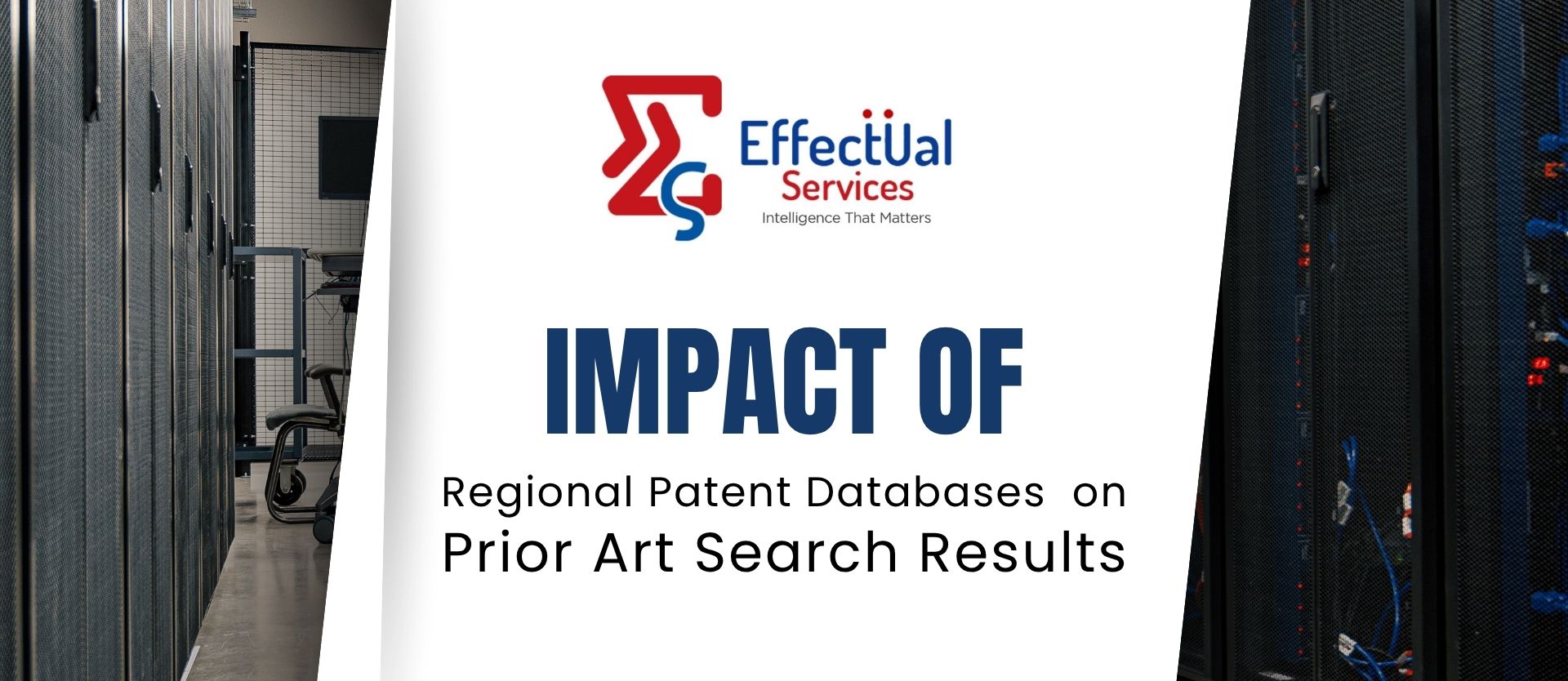Impact of Regional Patent Databases on Prior Art Search Results

In the dynamic world of intellectual property (IP), conducting a comprehensive prior art search is pivotal to ensuring that a proposed invention is novel, non-obvious, and eligible for patent protection. The prior art search identifies existing patents, scientific literature, and technical disclosures that could influence the patentability of an invention. Global patent databases such as those maintained by the United States Patent and Trademark Office (USPTO), the European Patent Office (EPO), and the World Intellectual Property Organization (WIPO) are commonly used to conduct such searches. However, regional patent databases, which are tailored to specific geographic areas, also play a critical role in improving the quality and scope of prior art searches. These databases contain patent documents that may not be available in broader global databases, providing crucial insights into regional innovations, legal standards, and technological trends.
This article explores the impact of regional patent databases on prior art search results, highlighting the advantages and challenges of using these specialized resources.
Understanding Regional Patent Databases
Regional patent databases are repositories of patent documents issued by patent offices within a specific geographical region. These databases typically include patents granted by national patent offices or through regional cooperation frameworks. Notable examples include:
- European Patent Office (EPO) – Espacenet
The EPO provides Espacenet, a comprehensive patent database that covers patents granted across European countries. Espacenet allows users to search for patents filed under the European Patent Convention (EPC), providing access to millions of patent documents in multiple languages. It is one of the most widely used resources for patent searches in Europe.
Website: Espacenet
- Japan Patent Office (JPO) - J-PlatPat
The JPO operates J-PlatPat, an online database that offers access to patents filed in Japan. It is one of the most reliable sources for patents in Japan, with detailed information about patent applications, granted patents, and utility models. J-PlatPat is crucial for evaluating Japanese technological developments and ensuring that inventions meet the novelty requirements in Japan.
Website: J-PlatPat
- China National Intellectual Property Administration (CNIPA)
CNIPA provides access to patents filed in China. The database is a critical tool for searching Chinese patents, which have become increasingly important as China emerges as a global leader in innovation. CNIPA’s search tool offers access to patents, utility models, and industrial designs filed under Chinese jurisdiction.
Website: CNIPA
- India Patent Office (IPO)
The Indian Patent Office offers an online database where users can search for patents filed within India. This database includes detailed patent applications and granted patents, offering valuable insights into India’s growing IP landscape. The IPO database is essential for assessing the patentability of inventions within the Indian market.
Website: Indian Patent Office
- African Regional Intellectual Property Organization (ARIPO)
ARIPO provides access to patents filed in member states across Africa. The database is especially useful for understanding patent protection in multiple African countries that are part of the ARIPO system. It is a key resource for those seeking to protect their innovations in Africa.
Website: ARIPO
- Korean Intellectual Property Office (KIPO)
KIPO operates a searchable database for patents filed in South Korea. South Korea is known for its strong innovation ecosystem, particularly in electronics and automotive industries. KIPO’s database provides access to patent documents, utility models, and designs filed under Korean jurisdiction.
Website: KIPO
- Canadian Intellectual Property Office (CIPO):
The CIPO offers a public database to search for patents filed in Canada. This includes full-text patent searches, legal status updates, and a wide range of patent-related documents for innovation assessments within Canada.
Website: CIPO
- Gulf Cooperation Council (GCC) Patent Office
The GCC Patent Office handles patents for the six countries in the Gulf Cooperation Council (Bahrain, Kuwait, Oman, Qatar, Saudi Arabia, and the UAE). The regional patent system facilitates patent protection across the member states, and its database is valuable for anyone looking to explore patent applications and granted patents in the Gulf region.
Website: GCC Patent Office
These databases are especially useful in accessing patents relevant to regional legal systems, market conditions, and technological landscapes. Although global patent databases often provide a broad search, regional databases allow more in-depth and focused examination of patents specific to the region.
Key Impacts on Prior Art Search Results
- Regional Scope and Relevance
Regional patent databases provide access to prior art that is specifically relevant to the jurisdiction in which a patent application is filed. Patentability requirements, including novelty and inventive step, differ from one jurisdiction to another. For example, an invention that may be considered novel and non-obvious in the United States might not meet the same criteria in Europe or Japan due to differing legal standards.
- Localized Innovations: Innovations that are designed to meet regional market needs may only be captured in patents filed within that jurisdiction. For instance, a new agricultural technology developed in India may only be found through the Indian Patent Office, even if the technology has global implications. By utilizing regional patent databases, patent examiners can assess whether an invention meets local novelty standards.
- Contextual Relevance: By searching regional patent databases, patent professionals ensure that prior art from relevant regions is considered, providing a more accurate and context-specific evaluation of patentability.
- Filling Gaps in Global Databases
Global patent databases, while comprehensive, often contain gaps or rely on outdated or incomplete data. Regional patent databases can fill these gaps by providing access to patents that may not yet be incorporated into global systems, or by offering more up-to-date information.
- Patent Filing Delays: There may be delays between when a patent is granted and when it appears in global patent databases. Regional patent databases, however, offer direct access to more current patent filings, helping patent professionals stay up to date.
- Unpublished or Non-Patent Literature: Regional patent offices may also provide access to unpublished applications, non-patent literature (NPL), and local research, which might not be captured in global patent databases but could still be critical for evaluating patent novelty.
- Unique Patent Characteristics
Each jurisdiction has specific legal frameworks that influence patentability criteria. This results in patent documents that may contain unique characteristics or interpretations based on the local laws governing patent filings. Regional patent databases offer insight into these specificities, ensuring that prior art searches are comprehensive and legally relevant.
- Invention Criteria: For example, patent laws in the European Union often have stricter standards for inventive step than those in the United States. By searching regional patent databases, patent professionals can gain a clearer understanding of how specific jurisdictions evaluate patentability.
- Patent Format and Scope: Regional patent offices may have different standards for the scope of claims, and their classification systems might be tailored to local technological fields. Regional patent databases help users navigate these differences by offering direct access to patents that reflect local filing practices and legal interpretations.
- Access to Local Innovations
Regional patent databases offer valuable insights into innovations that might not be captured in broader global databases. These innovations often address region-specific challenges, such as local environmental concerns, economic factors, or technological needs, making them highly relevant for assessing novelty within a particular jurisdiction.
- Technological Leadership in Emerging Markets: Regions such as Asia, Latin America, and Africa are witnessing rapid innovation, and regional patent databases can provide early access to these groundbreaking inventions. For example, a new renewable energy solution developed in Africa may be found through the African Regional Intellectual Property Organization (ARIPO) patent database.
- Strategic Importance: Identifying early-stage innovations in emerging markets can offer valuable insights into global trends. For businesses and researchers, regional patent databases are a critical resource for spotting potentially disruptive technologies in specific markets.
- Language Barriers and Translation Issues
A major challenge when using regional patent databases is language differences. Many patents are filed in the native language of the issuing country, and patents from non-English-speaking countries can be difficult to navigate. Regional patent databases often provide tools or services to help users overcome these barriers.
- Translation Services: Many regional patent offices offer machine translation tools or human translation services, making it easier to understand patents filed in foreign languages. For instance, the European Patent Office (EPO) provides machine translation for patents filed in several European languages, while the Japan Patent Office (JPO) offers translation services for Japanese patents.
- Language-Specific Search Queries: Regional patent databases may also offer advanced search features that allow users to refine queries based on specific keywords or technical terms in different languages, helping to overcome the challenges posed by language differences.
- Legal and Policy Differences
Patent laws vary significantly across regions, and these differences can affect the evaluation of prior art. For example, the definition of "novelty" and "inventive step" can differ between jurisdictions, and regional patent offices may have different practices for evaluating patent applications.
- Regional Legal Frameworks: Regional patent databases provide insights into how patents are evaluated under local legal frameworks, ensuring that the search results reflect the specific criteria required for patentability in that jurisdiction.
- Patent Strategy and Litigation: By searching regional databases, patent professionals can also gain insights into litigation trends and patent strategies within specific jurisdictions, which is essential for companies considering filing patents or engaging in patent disputes in those regions.
- Cost-Effective and Efficient Search Strategies
Using regional patent databases can be a more cost-effective and efficient way to conduct a prior art search. Searching global databases can be expensive and time-consuming, especially when the focus is on specific regions or markets. Regional patent databases allow users to narrow down their searches to relevant jurisdictions, helping to reduce costs and time spent on irrelevant results.
- Targeted Search Results: By focusing on a specific region, patent professionals can streamline the search process and avoid unnecessary search fees associated with broad, global searches.
- Customized Search Filters: Regional databases often offer specialized filters, such as local classification codes, legal status, and filing dates, allowing for more precise and focused search results.
Way forward
Regional patent databases are essential for uncovering local innovations, addressing legal nuances, and filling gaps in global searches. They enhance the accuracy and relevance of prior art searches, especially in emerging markets. Despite language and legal differences, they provide strategic value and should be a core part of any comprehensive IP search strategy.
Solutions Driving Innovation & Intelligence
Enabling Fortune 500's, R&D Giants, Law firms, Universities, Research institutes & SME's Around The Globe Gather Intelligence That
Protects and Nurtures Innovation Through a Team of 250+ Techno Legal Professionals.

